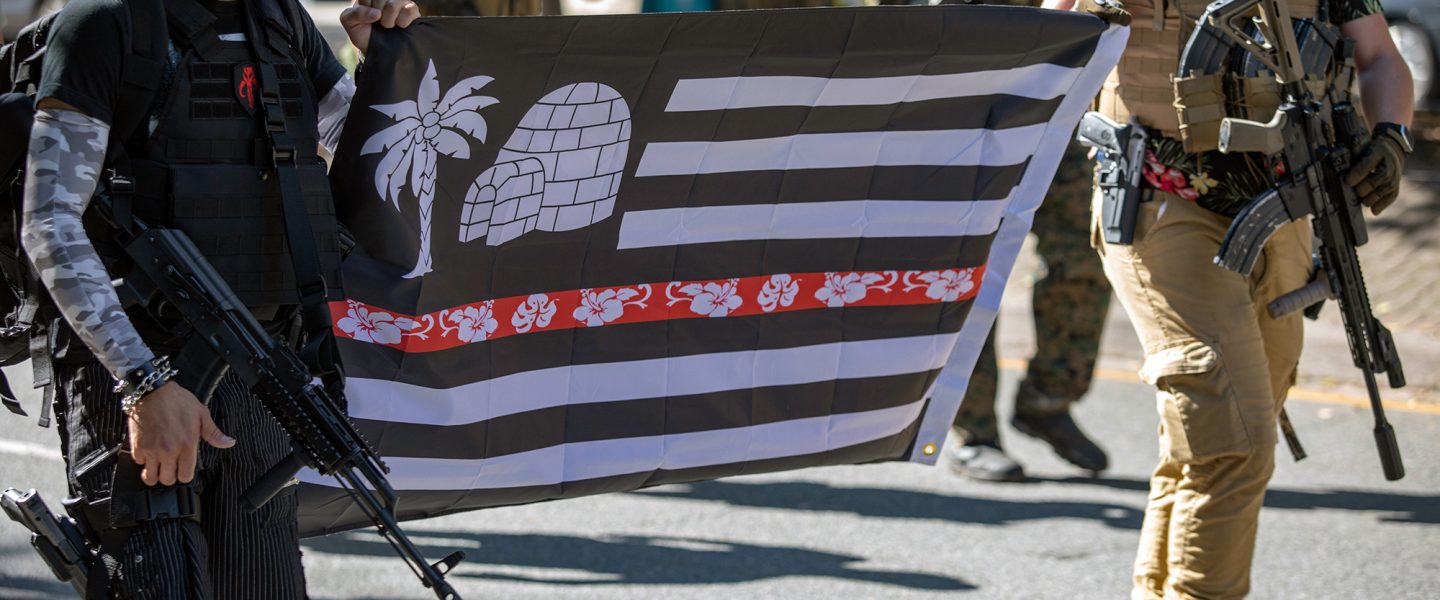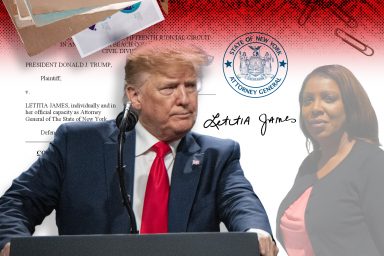The extreme Right’s adoption and use of left-wing language is ultimately a move to channel popular discontent to their own violent ends.
|
Listen To This Story
|
Deciphering the language, symbols, and memes of our modern political landscape is no easy task, especially when it comes to extremism. As if the din of dog-whistles and doublespeak weren’t confusing enough, extremists on the Far Right have also taken to co-opting and adapting left-wing language, ideologies, and symbols to fit their own needs.
This all makes for a strange rhetorical cocktail that reveals much about this strange and tumultuous time in American politics.
Alexander Reid Ross, a researcher and author focusing on the transnational Far Right, suggested this may stem from certain means shared by the Right and the Left, despite their very different end goals:
There’s a kind of symbiosis where the revolutionary left wants to destroy liberal democracy because it doesn’t go all the way in fulfilling [their] ideals of freedom and equality, while the revolutionary right wants to destroy that system as well, for precisely the opposite reasons. And so to some extent it’s cribbing from the left and is developing a unique kind of radicalism and revolutionary ideology that can look a lot like the left but is its own beast.
Reid Ross also pointed out that as parts of the Far Right moved from more traditional reactionary and conservative worldviews to more revolutionary ones, they co-opted and adapted the revolutionary language and ideologies of the Left, which had originally created the intellectual basis of revolutionary ideology.
When Right Siphons Left
There are a myriad of motivations for far-right extremists to incorporate left-wing language, ideologies, and figures into their worldview, ranging from recruitment to genuine influence.
“It’s definitely more muddy than people think,” said Spencer Sunshine, a researcher and author focusing on white supremacist movements. “There is certainly intentional co-option … and there is legitimate influence that may be seen as co-option but is just rightwingers being influenced by the left.” Sunshine’s book Neo-Nazi Terrorism & Countercultural Fascism, slated for publication in early 2024, investigates this topic extensively.
Both Sunshine and Reid Ross pointed out that many figures on the Far Right were deeply influenced by left wing thought because they themselves had formerly been involved in leftist causes and organizing. Prime examples include Benito Mussolini, the father of fascism who was formerly a socialist ideologue; Wyatt Kaldenberg, a former Trotskyite who later helped bring anti-capitalist ideologies to the violent neo-Nazi group White Aryan Resistance; and Horst Mahler, a former leftist militant who became a lead neo-Nazi organizer in Germany.
Some neo-Nazis have even co-opted and created their own versions of a popular antifascist symbol, created in the 1930s by the Communist Party of Germany and the leftist Social Democratic Party.
Recently, this far-right encroachment into leftist ideological territory has played out in the unlikely political friendships of the Boogaloo Movement, a loose coalition of right-wing, anti-government extremists. Specifically, Boogaloo adherents have sought alliance with a small subsection of the Left, bonding over their shared hatred of the government and police.
The Boogaloo Movement has generated much debate over their co-option of leftist language and causes. While, as Reid Ross points out, the movement is not an ideological monolith, many adherents have expressed support for left-wing ideologies and causes, such as anarchism and the Black Lives Matter movement, going as far as to wear Black Lives Matter or anarchist patches on their clothing alongside symbols associated with far right militias.
“They want to sow chaos. … Their first intention is to bring about the collapse of the United States, and one way of doing it is reinforcing and militarizing all sides of the political opposition in their most extreme formulations,” said Reid Ross, emphasizing that their embrace of more openly insurrectionary leftist politics is more opportunistic and tactical than genuine.
Historical Precedents
Despite its visibility in recent American political unrest, the crossover of language is not a new phenomenon.
Reid Ross gave the example of neo-fascist movements in 1970s Italy, which used leftist organizing models and language, such as rebellion against authority and individualism, to appeal to younger crowds:
By introducing these left wing currents on a flank of the fascist movement they could assure kids who wanted to rebel against the left wing consensus in schools that they could still feel cool and do everything the left wingers did. That enabled them to recruit youth.
The Boogaloo Movement and Italian neo-fascists have certainly mimicked left-wing language to accomplish their goals, but have co-opted primarily surface-level characteristics from the Left, such as organization and behavior. Others on the Far Right have been much more deeply influenced by the Left, incorporating their ideologies and icons into the core of their own right-wing worldviews.
By adopting left-wing language, symbols, and ideologies of revolution, the Right has tried to mine and exploit all lodes of discontent.
Another prime example of this odd language exchange is an obscure neo-fascist intellectual movement that emerged in France in the late 1960s. The European New Right (ENR) was a school of thought that in essence tried to repackage fascist, ethno-nationalist, and Far Right ideologies in progressive and leftist language to make them more palatable.
Far-right intellectuals of the ENR across Europe sought to create a cultural, social, and political space for a new form of neo-fascism, and in doing so, fused philosophy and thinkers from across the political spectrum, including many figures on the Left. The ENR took inspiration from the Italian Marxist intellectual Antonio Gramsci, and actively championed and supported anti-colonial liberation movements and figures such as Che Guevara.
For example, according to far-right-extremism expert Matthew Lyons in his essay “Ctrl-Alt-Delete”:
[The ENR] argued that true antiracism requires separating racial and ethnic groups to protect their unique cultures, and that true feminism defends natural gender differences, instead of supposedly forcing women to “divest themselves of their femininity.”
The ENR, while itself obscure, achieved significant influence via its adaptation of language, including on major policy advisors in the United States and beyond. Steve Bannon, a former White House strategist and itinerant confidant of President Donald Trump, has expressed ideologies similar to or inspired by those of the ENR.
Aleksandr Dugin, a major Russian far-right intellectual figure closely associated with ENR, also has had enormous influence in that country. Dugin and his allies in the Russian New Right have enjoyed the patronage of powerful Russian military leaders and policymakers. He is also considered a major ideological influence behind Vladimir Putin’s invasion of Ukraine.
Dugin, while a staunch anti-communist since the final days of the USSR, actively took inspiration from the Left as well, with a significant element of his ideology revolving around resistance to US and Western imperialist hegemony, a classic leftist talking point.
Whether or not these crossovers of extremist ideologies have had as much impact on powerful figures as the ENR has, appealing to left-wing language has revitalized the ideologies of the extreme Right and given them new appeal in this environment of mass political discontent.
The Far Right’s Quest to Enlist All the Discontented
In many ways this phenomenon — a melding of the extreme ends of the spectrum — points to the wider instability of America’s political landscape. Recent studies and polls point to an increasing trend across the political spectrum of distrust of the federal government and belief in political violence as a means to achieve political goals.
The language exchange between left- and right-wing extremism demonstrates how extremists capitalize on common grievances against “the system”. By adopting left-wing language, symbols, and ideologies of revolution, the Right has tried to mine and exploit all lodes of discontent.
Unfocused but justified rage at the deep flaws and inequities in American politics can lead many, especially young people, to be wooed by the convenient hatreds of the Far Right that have been glossed over with the revolutionary ideas and language of the Left.
This has resulted in a strange convergence between the Far Right and causes or people that would be traditionally considered leftist. The language and ideologies of revolution, traditionally bound to the Left, have come to appeal to those all the way across the political spectrum.
Unfocused but justified rage at the deep flaws and inequities in American politics can lead many, especially young people, to be wooed by the convenient hatreds of the Far Right that have been glossed over with the revolutionary ideas and language of the Left.
“Hangers on or people who don’t actually have a commitment [to an ideology] and might like some of the left-wing stuff but not necessarily the ideals — those are the ones most likely to be recruited,” Sunshine elaborated, going on to mention that this crossover often happens in single-issue political groups, such as environmentalist and anti-war causes. Sunshine’s essay “Drawing Lines Against Racism and Fascism” further warns leftist and countercultural movements against such far-right encroachments.
“Politics are fluid and they float around. Some people embrace a diversity of views, and if they don’t place boundaries to that, then far-right views can come in,” concluded Sunshine.
It may be easy to dismiss extremists as irrational idealists or fringe lunatics, but despite their small numbers, those on the political fringe are able to have an oversized political impact. This is precisely because of their ability to exploit and channel common grievances across the political spectrum.
The extreme Right’s adoption and use of left-wing language is ultimately a move to channel popular discontent to their own violent ends, and as American politics become more polarized and tumultuous, we likely won’t see the revolutionary fervor of the Far Right go away any time soon.




